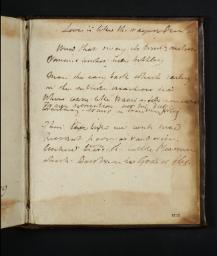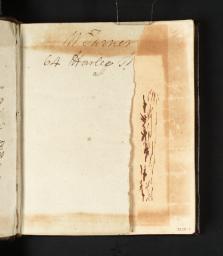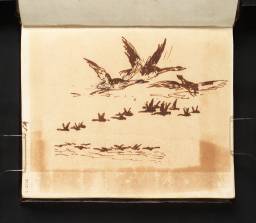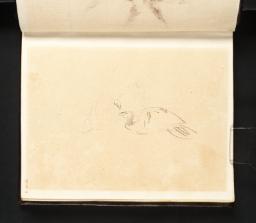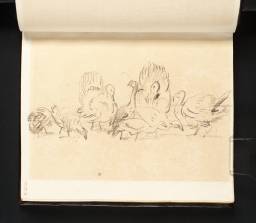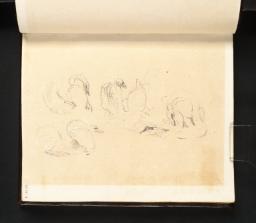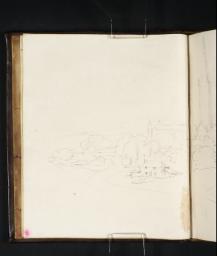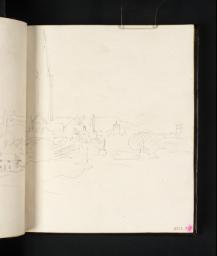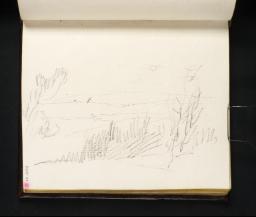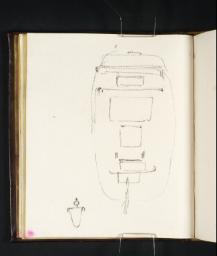Turner Bequest XLIX 1–83
Sketchbook bound in boards covered with calf leather, with gold-tooled covers and spine
83 leaves of white laid paper and 2 flyleaves and paste-downs of coarser white wove paper, all edges washed in yellow; page size 150 x 121 mm; watermark: Britannia above a ‘G’ in an oval surmounted by a crown, countermarked ‘Gater | 1799’
Made by John and Edward Gater, Up Mill, South Stoneham, Hampshire
Numbered 308 as part of the Turner Schedule in 1854, and endorsed by the Executors of the Turner Bequest, Henry Scott Trimmer, Charles Turner, Charles Lock Eastlake and John Prescott Knight on verso of unaccessioned rear flyleaf inverted relative to the sketchbook’s foliation, in ink ‘No 308 | Contains 20 leaves in Pencil | sketches H.S. Trimmer – C Turner’ and in pencil ‘C.L.E.’ and ‘JPK’
Blind-stamped with Turner Bequest monogram on back cover
Inscribed in pencil ‘XLIX’ on verso of rear flyleaf
83 leaves of white laid paper and 2 flyleaves and paste-downs of coarser white wove paper, all edges washed in yellow; page size 150 x 121 mm; watermark: Britannia above a ‘G’ in an oval surmounted by a crown, countermarked ‘Gater | 1799’
Made by John and Edward Gater, Up Mill, South Stoneham, Hampshire
Numbered 308 as part of the Turner Schedule in 1854, and endorsed by the Executors of the Turner Bequest, Henry Scott Trimmer, Charles Turner, Charles Lock Eastlake and John Prescott Knight on verso of unaccessioned rear flyleaf inverted relative to the sketchbook’s foliation, in ink ‘No 308 | Contains 20 leaves in Pencil | sketches H.S. Trimmer – C Turner’ and in pencil ‘C.L.E.’ and ‘JPK’
Blind-stamped with Turner Bequest monogram on back cover
Inscribed in pencil ‘XLIX’ on verso of rear flyleaf
Accepted by the nation as part of the Turner Bequest 1856
References
This small book, which contains many blank leaves, is similar in some respects to the Swans sketchbook (Tate; Turner Bequest XLII), and may have been acquired by Turner at the same time. Both contain drafts of poetry, either original or copied from elsewhere. The leather covers are alike, though the fine tooling is slightly different in each and the slightly larger Swans book had a (now missing) brass clasp. The paper of the Swans book is much coarser, and it is interesting that Turner seems to have found this a more congenial surface for his purposes at this time of experiment than the more refined white laid paper of the Salisbury book.
In 1799 he received a commission from Sir Richard Colt Hoare (1758–1838) of Stourhead, Wiltshire, to make drawings of Salisbury Cathedral which was in the process of being restored by James Wyatt (1746–1813). Wyatt was also working on the great Gothick Abbey at Fonthill for William Beckford (1760–1844), and commissioned Turner to make views of that building in the course of its construction about this time. The various architectural details noted down in this book relate to the Salisbury commission; studies on the versos of folios 78–82 (Tate D02332, D02334, D02336, D02338, D02340; Turner Bequest XLIX 78a, 79a, 80a, 81a, 82a) were used for finished watercolours, as noted in the individual entries. The somewhat scrappy studies of boats do not seem to refer to any of the major marine paintings on which he was engaged around the turn of the century, but will have been made out a general interest in such matters.
Finberg records a ‘parchment label [since lost] on back [i.e. the spine], blank but for the number “52” on it in ink.’1 He also notes John Ruskin’s endorsement on a wrapper, also since lost: ‘308. Empty except a boat or two and some studies of York [sic]. Four taken out for M.H.’2 This indicates drawings extracted for early display at London’s Marlborough House: the rectos of folios 1–4 (D02243–D02246).
Technical notes
How to cite
Andrew Wilton, ‘Salisbury Sketchbook c.1799’, sketchbook, March 2013, revised by Matthew Imms, February 2015, in David Blayney Brown (ed.), J.M.W. Turner: Sketchbooks, Drawings and Watercolours, Tate Research Publication, April 2015, https://www

